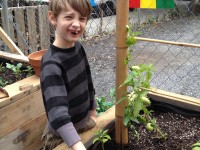Growing up in Jamaica, Jimmy and his friends fed the island’s rabbits a diet that any human would envy: bananas, cabbage, grapes, apples and mangoes. Today, four decades later, the 59-year-old lives in Bedford-Stuyvesant, a residential Brooklyn area that boasts many Caribbean and Latin American immigrants. In a world of concrete and row houses, he and his neighbors are a world away from the easy connection to nature and fresh food that many of them enjoyed before moving to New York City.
One Kin Farm, a partnership with 596 Acres
Learn more about this week’s Awesome Project and keep up with their progress!
“Some of the kids we’ve met literally don’t know that a tomato plant produces tomatoes – the red things, the things you eat.”
ioby Project Leader Bree Hietala is out to change that. Since May, she and a small army of smiling volunteers have been building the One Kin Farm on a vacant lot on Greene Avenue and Tompkins Avenue in Bedford-Stuyvesant. In her words, they plan to fix “the broken bond between people and food” by giving local residents a chance to both grow their own food and to reconnect with nature. Like Jimmy, many of the neighborhood’s residents have lost the association with fresh food that they knew in their youth in other countries and cities.
Others, who have lived their whole lives in the city, are unaware that they are missing a connection at all. Buying food from bodegas—small markets located on nearly every New York street corner—means that most children never see where their food is coming from beyond the other side of the deli counter. “Some of the kids we’ve met literally don’t know that a tomato plant produces tomatoes – the red things, the things you eat,” says Kevin Boyd, another of the garden’s founders.
One Kin Farm is currently growing grapes, raspberries, kale, arugula, cucumbers, potatoes, radishes, collards, squash, peppers and broccoli, and plans to give away the produce for free. People in the neighborhood will be able to watch their food make the full journey from soil to table, without ever coming into contact with Saran wrap or passing by a cash register.
“What they’re doing here is giving my kids a safe space to come and be outside.”
Locals who want to use the space to reconnect with nature don’t have to wait until the harvest. During ioby’s visit to the site, Jimmy stops by to check on Uno and Kinny, the two resident rabbits. These bunnies have quite the social life; a steady stream of visitors stops by their enclosure, while Jana Hawkins watches from her third-floor window. Hawkins and her family moved to the neighborhood at around the same time as One Kin Farm, and already she is amazed at the impact it has had on her children.

 “A lot of the dirt in the neighborhoods in Brooklyn and New York has high levels of lead, and so you can take your kids to the playground or to the museum or another great ‘New York’ thing, but you can’t necessarily let them play safely in their own backyard,” she explains. “What they’re doing here is giving my kids a safe space to come and be outside.”
“A lot of the dirt in the neighborhoods in Brooklyn and New York has high levels of lead, and so you can take your kids to the playground or to the museum or another great ‘New York’ thing, but you can’t necessarily let them play safely in their own backyard,” she explains. “What they’re doing here is giving my kids a safe space to come and be outside.”
“Here, the community can come together and cook and create and have fun.”
Hawkins’ son Sal chose to plant his house plants in one of the farm’s aquariums when they moved in, and he’s fascinated by their progress. “You can see the root systems now!” the seven-year-old says excitedly. “The garden is doing a much better job taking care of our plant than we did.” His three-year-old sister doesn’t yet grasp the significance of the growing shoots and vines in the garden, but she makes full use of the free play zone at the back of the lot.
The degree of neighborhood participation after just one month is a testament to Hietala and Boyd’s commitment to engaging with the community. As they started to transform the vacant lot, they made sure to greet everyone who walked by, asking each person what they wanted to see growing at One Kin Farm. Soon the collards and kale that these neighbors have requested will be ready to eat, and everyone will gather in the large space behind the rabbit hutch to celebrate the event. “Here, the community can come together and cook and create and have fun,” says Heitala.
For some, the positive change is already being felt. “It feels good to see them here,” Jimmy says, gesturing at Uno and Kinny as they cheerfully oversee raised beds constructed from recycled wooden pallets, dresser drawers, and old aquariums. One can’t help but imagine the scene forty years in the future, when the children who grow up next to One Kin Farm will tell their own stories about feeding the local rabbits.
One Kin Farm raised $674 on ioby. Click here to keep up with their progress!



